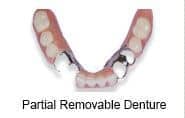
What is a removable dental bridge?
Removable bridges or removable partial dentures are appliances made to replace one or more missing teeth in an arch.
Removable bridges all use the same type of tooth material but are differentiated by the materials used to hold the teeth to the partial denture and the way the partial denture attaches to the two (or more) teeth left in the arch (upper or lower).
What choices of partial dentures do I have?
Permanent partial dentures, also know as cemented bridges, provide a low-maintenance option in replacing missing teeth.
Temporary Acrylic Removable Partial Denture
Known as the “Flipper” in dentistry, this is generally the least expensive alternative to replacing missing teeth. Some flippers have a wire clasp to help attach the acrylic base to the teeth while others have no clasps at all. These removable partial dentures have an acrylic base made exactly the same as a complete denture. The biggest benefit of this type of removable partial denture is that it can be made before any teeth are removed and delivered the same day as the extractions are done. Then, if more teeth need to be removed later, teeth can be added easily and economically to the flipper.
Flippers have a number of disadvantages:
- They tend to be somewhat irregular in shape and the acrylic is brittle. These partial dentures tend to break frequently, especially in the lower arch or when functioning against a single upper central replacement tooth.
- For strength the acrylic tends to be thicker than other types of partials and may be more difficult to become accustomed to.
- They tend not to be as retentive or stable as removable partials that are retained by clasps around the teeth.
- Since they rest on the tissue, they tend to sink below the level of the teeth over time and need to be replaced, thus the term “temporary.”
Cast Framework Partial Dentures
As the name implies, these are partial dentures which have a cast metal framework supporting denture acrylic and teeth. These partials are mainly tooth supported and retained and are therefore extremely stable. The metal framework is cast extremely thin and is therefore much less noticeable than the acrylic framework partials. The clasps are designed to retain the partial in place and the teeth are altered slightly to allow the patient to bring teeth all the way together without interfering with the clasps. This also makes it possible to place the clasps in positions which are less visible than wire clasps. The cast framework is also very strong and is less likely to break than acrylic, and since the metal does not rest on tissue, but on teeth, these partials do not sink below the level of the teeth. Finally, since there is little contact with the soft tissue, sore spots are not much of a problem.
Flexible Framework Partial Dentures
The newest types of partial dentures are made from a nylon-like material and are called Valplast (the most common) or Flexite partials. This material replaces the metal and acrylic of a standard partial denture. The clasps that hold the partial to the teeth are made of the same pink material and are generally indistinguishable from the gums, a very nice aesthetic advantage. The material is also nearly unbreakable so it can be made quite thin, a distinct advantage over the acrylic framework partials.
One disadvantage to these partials is that they are supported more by tissue, so they are more likely to create sore spots. It generally takes more time to adjust the denture and eliminate these sore spots. Flexibility can be a liability with heavy use.
Combination Metal Framework with Flexible Clasp Partials
For the patient with high aesthetic demands who also needs the most stable framework possible, we are now able to make a metal framework with clasps made of the pink material used in Valplast or Flexite partials. This allows us to hide the clasps while alleviating many of the sore spot problems associated with flexible frameworks.
The Manhattan Dentist, Dr. Binder will spend time consulting with you on which removable partial denture is best for you.